Magical Industrial Inspiration
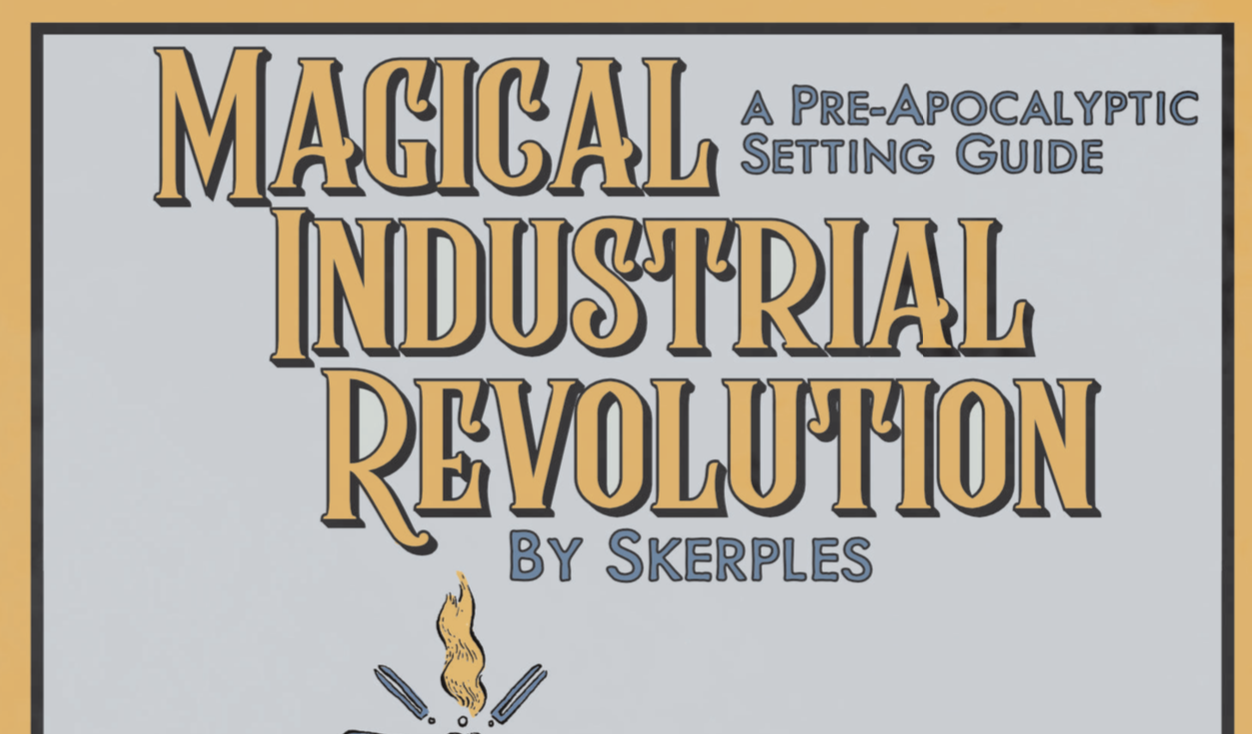
Magical Industrial Revolution is a toolbox packed with steampunk magical content. The focus of this review will focus on “inspiration vs information”, and layout. Because, as I keep repeating:
A well-presented mediocrity is worth infintely more than buried brilliance. If I have to read through 400 pages of crap to parse the good stuff, your book will gather dust. It just so happens that creators who put a lot of work into their presentation usually put as much or more work into their content. Solid presentation and good ideas usually go hand in hand.
And Magical Industrial Revolution has excellent presentation for fantastic inspirations.
Inspiration Permalink
As a GM I find cities intimidating to manage. Cities are packed with sights, smells, sounds, and hundreds upon hundreds of people. Every street has a life of it’s own, every building has a name, and every NPC is unique. There is no way I could memorize a city well enough to describe it to the players.
However that’s how a LOT of RPG books expect me to handle cities. RPG books will show a huge map with 100+ locations on specific strets. They read like this:
67. The Silk Scabbard was once an old warehouse, but has been renovated into a candle shop. The patrons of the tavern across the street always complain about the smell. The sign out front is… 5 more paragraphs of information …but the backdoor is always locked. Albut Modum (pg. 134) holds the key, and he stays at the Crocked Crook Inn (pgs 78-80) during the week.
So for this ONE location I need to memorize nearby buildings, several NPCs, and a dozen little details. I don’t care if all of the information is brilliant, that’s TOO MUCH for a single location; one of dozens in the city.
That would be like memorizing every 5ft square in a small dungeon. “This square contains blah blah blah, and sometimes items from other squares can interact with it like…”
That’s gonna be a NO from me, dawg. I’ve bought 3-4 city supplements for RPGs, and they all just sit on my shelf gathering dust. I don’t want to invest the time and energy to memorize an entire city.
That’s one reason Magical Industrial Revolution is such a relief. It doesn’t contain information you need to memorize; rather it includes inspiration for your OWN ideas. Most of the “details” in the book are little more than random table entries. There is a “City Map”, but it describes 25 different regions of the city in a few sentences, and lets you roll on tables to fill in the missing details.
In between pages of cool tables are cloumns of advice on how magic works in a city settings, portraying the sights and sounds of Endon, and structuring your adventures around the madness. Because the city of Endon is utterly bonkers.
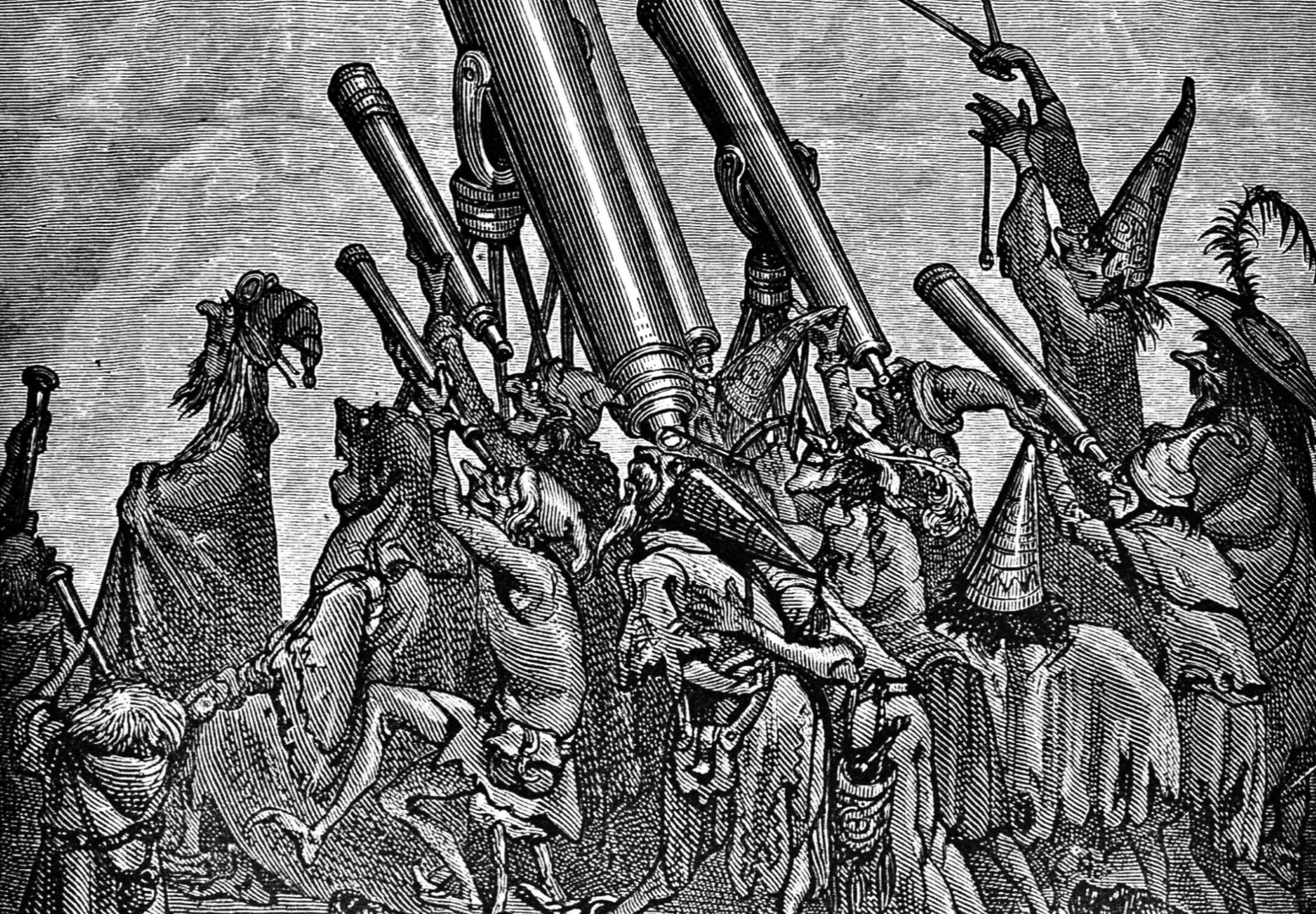
Countdown to Armegeddon Permalink
One of the big gimmicks of this city setting is that it has a self-destruct button built into it. 8 of them, actually. Hence the “pre-apocalyptic” tagline.
8 different apocalypses are included in the book, each one starting off as a magical innovation of some kind that grows in scope until it eventually blows up the city/world/universe. Each one is cleverly written with clear stages of escalation and includes some ideas to avert them.
Every few sessions you roll to see how each apocalypse escalates, and how each one affects the city. It’s elegantly abstracted into a fun little system. Here’s one simplified example from the book:
- Initial Innovation: A wizard creates a magical weapon: a rod that accellerates quickly.
- Public Introduction: A chair with several rods attached to it. Awkard but functional.
- Widespread Adoption: These flying contraptions are all over the city, and growing more popular.
- Scope Alteration: Rods get stronger and faster. More like fired bullets than flying machines.
- Height of Ambition: The creator starts to build a rocket using hundreds of rods.
- Terminal Events: If the rocket takes off, the force exerted downwards could destroy the city.
Averting this Apocalypse: Prove that the rods are unsafe, sabatoge the launch, invent a safer/cheaper form of travel.
The actual apocalypse in the book has more detail about how the rods work, how they are used in society, and how things quickly spiral out of control. Now imagine 8 of these apocalypses all festing and growing at the same time.
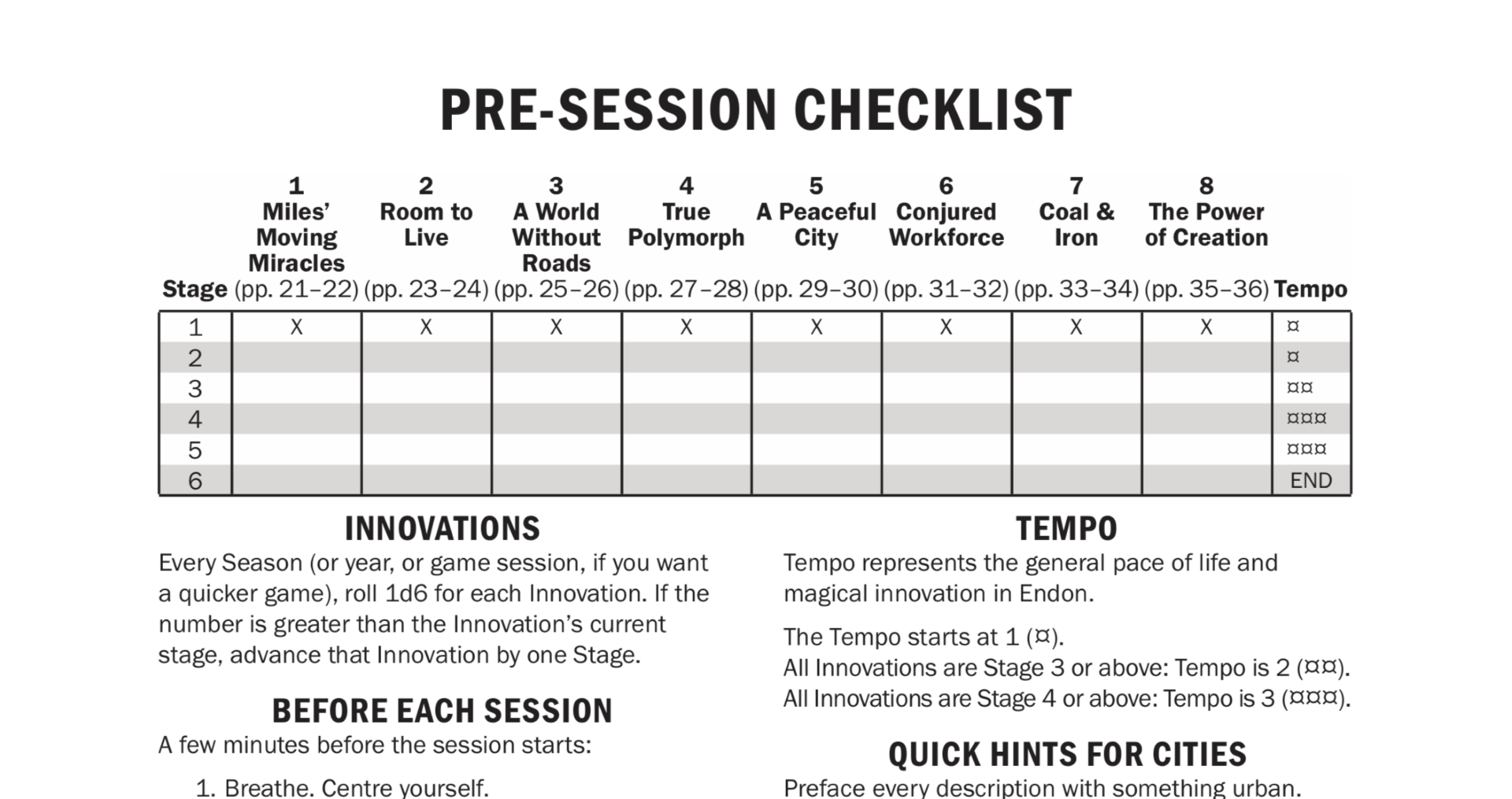
As the apocalypses escalate the “Tempo” of Endon gets more hectic. The Tempo affects hundreds of small things throughout the book, from random encounters to shop prices, to areas of the city. For example:
20. GRAND DOCKS
¤ A vast tangle of rock and wood. Small fishing boats, fat coal barges, foreign traders.
¤¤ New warehouses spring up like grey mushrooms. Iron cranes haul bales and sacks continuously.
¤¤¤ Larger vessels, more iron cranes, more workers. Routine maimings, habitual theft.
So after a few apocalypses have progressed you add the second and third lines to your descriptions of the area.
You encounter A ¤ 1HD ¤¤ 5HD ¤¤¤ 10 HD Mob (pg. 115). Peaceful, firm, and organized.
People get more “revolt-y” as apocalypses increase.
Minor Magic Item (pg. 93–96) ¤ 5gp ¤¤ 3gp ¤¤¤ 2gp
Item costs might got up or down as technology improves/explodes.
It’s hard to explain how cohesive the entire product really is. Everything from the layout to the writing makes the entire book run like a well-oiled magical engine. And you really get a feel for how the insanity rachets up as apocalypses get further along.
Presentation. Check. Permalink
Time to get up on my soapbox. Many of the other city RPG supplements I’ve read seemed like they were mean to be read and memorized rather than used at the table. Here’s an example spread from “Streets of Zoebeck”, the first disapointing city supplement I bought:
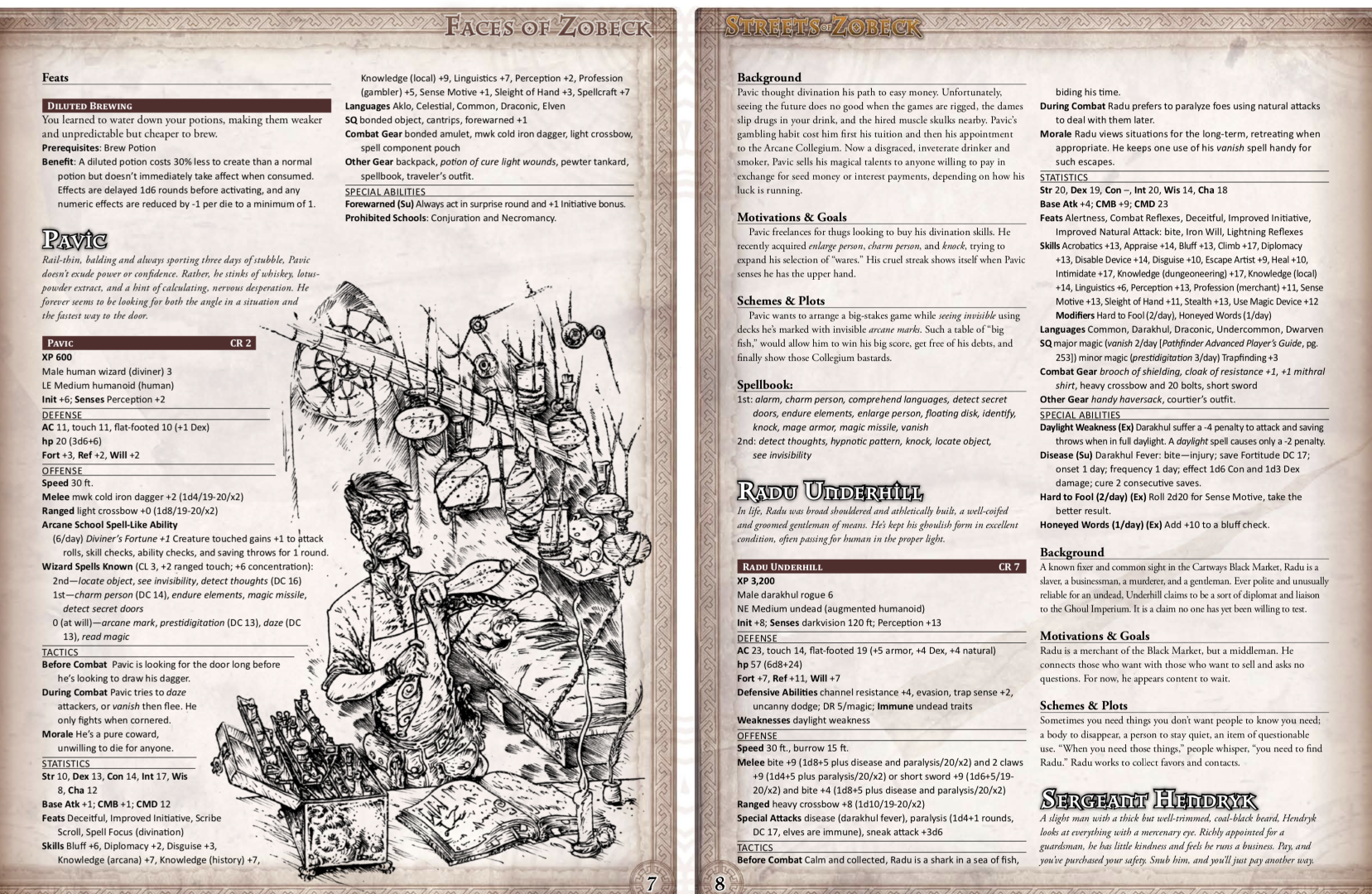
This is a list of 8 unique and powerful NPCs from the city of Zoebeck. Not only is that font+shadow hard to read, but see how the descriptions run off the page? You gotta flip a bunch of times just to read about one or two people. It takes more than a page to describe each person, and referencing them at a glance is basically impossible.
Compare this to Magical Industrial Revolution:
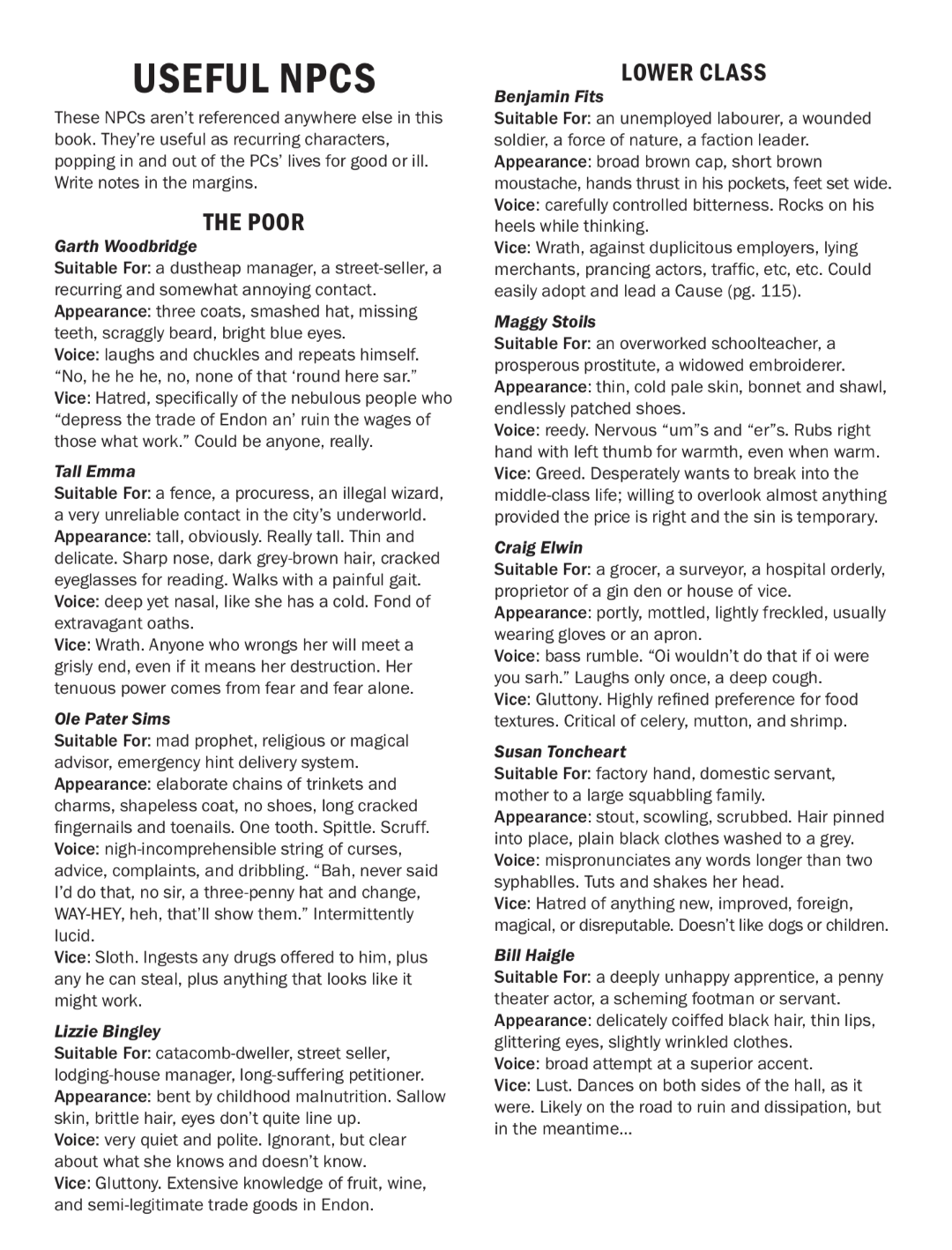
Clear, clean, simple. 8-9 NPCs fit on a single page. The first thing listed under each NPC is what they’re useful for. This person will buy questionable items. This person can get you a meeting with the mayor. This person is desperate for cash and will take any job.
This is the core of the book. Every page, every table, every detail aims to be USEFUL. And the presentation and layout reinforce this goal. Some examples:
- Tables are sub-divided into categories. A d100 table of buildings has sections like “poor buildings”, “shops”, “unusual”. You can still roll on the big table for ultra-randomness, but the sections make it easy to keep things to a consistent tone or area.
- Tables also list the dice along with the page number, so you can have your players roll dice while you flip to the tables. E.g. See Encounters (1d100, pg. 29). It’s a very small detail, but it shows that a lot of thought was put into how the book is ACTUALLY used during play.
- Countdown Checkboxes are referenced all over the place.
- The “Solve My Problems” sheet at the end of the book is just like…whoa. “Where can we sell magic items?” See pg 89 for reputable wizard shops, and pg 90 for disreputable wizard shops. “I’ve done something illegal” The coppers will show up soon (pg 45), and take you to a trial (pg. 103). Seriously, this sheet is a great reference for how to use the book.
- Reasons to visit Endon, broken down by DnD class (as a druid, you know Endon is threatning the balance of nature, etc).
- Almost all pages are self-contained; very little flipping is required (see the NPC list above).
- Advice and setting info are sandwiched between random tables. This makes it very informative to read through the first time, but the tables are still available for quick reference. It’s very clear what is meant to be read and understood, and what is meant to be accessed on short notice.
Conclusion Permalink
I feel like I could keep rambling about this thing for much longer. It is PACKED with content, inspiration, philosophy, jokes, and songs. And every page has something fresh and inspiring.
Instead of memorizing a city block, I can pick 4-5 details from a few tables and mash them together into my own thing.
If you’ve been intimidated by cities in the past, I highly recommend checking out Magical Industrial Revolution. The book is glorious, clean, and filled with more magical nonsense than 100 other books.
It’s good. I can’t wait to use it in my own games.